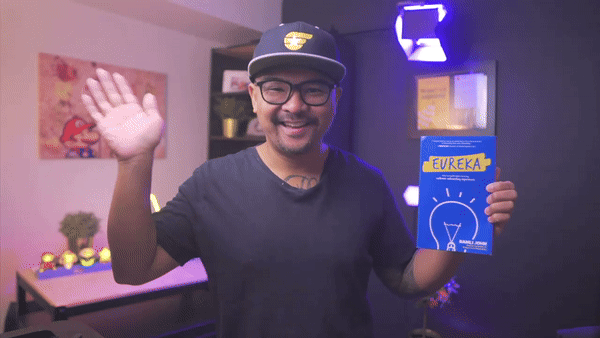Create AI-Enhanced Onboarding Email Sequences
Build personalized onboarding email sequence that actually converts—using AI the right way.
This is a preview of my new book, EUREKA: The Customer Onboarding Playbook for High-Growth B2B Companies (coming June 2025).
You can also pre-order it now to get bonuses like:
Early access to selected chapters
Exclusive frameworks and templates
Private community access
Launch day bonuses
Plus, subscribe to Delight Path for weekly insights and behind-the-scenes looks at how the book is coming together.
Enjoy the preview!
Free Workshop: Build an AI Agent With Me
Before we dig in, I'd like to invite you to another workshop I'm hosting—Build an Agent With Me: Scaling Personalized Onboarding. Next Wednesday, April 9, at 12:30 pm, Jacob Bank, founder of Relay, will create an AI Agent to automatically:
Research new users and their company (e.g. company size) on LinkedIn
Send a personalized email based on user/company attributes
Trigger a human task to connect with the user on LinkedIn
Integrate with sales/CRM systems to flag high-priority leads
Detect high-value users (e.g., senior leaders at large companies) and trigger a more personalized onboarding experience
(I'll share the recording with everyone who signs up).
Create AI-Enhanced Onboarding Email Sequences
Most companies approach AI writing by feeding generic prompts and hoping for the best. But as Sammy demonstrated, the secret to creating meaningful onboarding sequences lies in providing rich context from multiple sources:
Best Practice Documentation: Industry knowledge, expert content, and proven frameworks
Voice of Customer Research: Interview transcripts, customer calls, and feedback
Product Information: Help docs, feature guides, and support articles
Brand Guidelines: Tone of voice, messaging principles, and past communications
The key insight? AI's output is only as good as its input.
By giving it access to your institutional knowledge, customer research, and brand voice, you create a foundation for generating highly relevant, personalized content.
You can do this in ChatGPT by creating a detailed system prompt that includes your brand voice, messaging guidelines, and customer research.
In Lex, you can create context tags that automatically organize and pull in your institutional knowledge, making it even easier to maintain consistency.
Creating Persona-Specific Sequences
One of the most powerful applications we discovered was using AI to adapt onboarding sequences for different customer personas. Here's how it works:
Create separate folders for each customer archetype (e.g., academics, enterprises)
Add relevant research, interview transcripts, and use cases to each folder
Use context tags to pull in the latest customer insights automatically
Ask AI to adapt your core sequence for each specific persona
This approach ensures your onboarding emails speak directly to each customer segment's unique needs and pain points while maintaining consistency in your messaging.
Three Keys to AI-Enhanced Email Success
Through our workshop, we identified three critical factors for success:
1. Start with Quality Inputs
Don't expect AI to create compelling content from scratch. Feed it your best customer research, proven messaging, and successful past communications.
2. Iterate with Purpose
Use AI as a thought partner, not a replacement. Challenge its suggestions, test different approaches, and refine based on customer feedback.
3. Maintain Human Oversight
While AI can handle the "grunt work" of adapting content, human judgment remains crucial for ensuring emotional resonance and strategic alignment.
Building Your AI Knowledge Engine
The most powerful insight from our workshop wasn't just about writing better emails—it was about transforming how teams capture and leverage their collective knowledge. By building a rich context library in tools like Lex or NotebookLLM, you're not just improving your onboarding emails. You're creating an AI-powered knowledge engine that grows smarter with every customer interaction, every piece of research, and every successful campaign.
Think of it as building a living, breathing playbook that evolves with your business. When your next marketing hire joins, they don't just get templates—they get access to your team's accumulated wisdom, ready to be applied to any customer communication.
That's all for now, folks!
I'd love to hear your thoughts about this preview:
How are you currently using AI in your onboarding process?
What other AI use cases would you like to explore?
What challenges do you face in personalizing customer communications?
Leave a comment below.
And, of course, you can get exclusive updates, resources, and snippets from the book by subscribing to Delight Path.






Ramli, this is 🔥.
That line—“AI’s output is only as good as its input”—should be etched into every marketer’s playbook. Totally agree that the shift isn’t just about writing better onboarding emails. It’s about architecting a dynamic knowledge system that reflects your brand, voice, and customer realities.
I especially love the persona-specific folder/tag setup. That’s how we’re training our AI agents right now—feeding it transcripts, psychographic notes, and past winning sequences segmented by buyer archetype. The clarity and personalization you get from that? Unreal.
Here’s one question I’d love to see you riff on in the book:
How do you balance automation with emotional depth? Especially in the critical early onboarding phase where first impressions shape LTV.
My fav email onboarding framework: don’t just show off features, ensure to use pain-benefits framework.